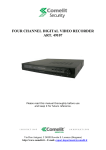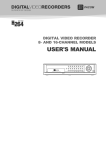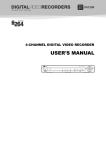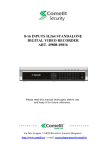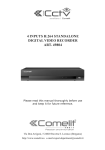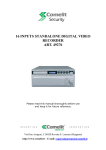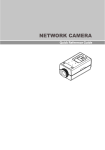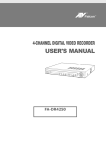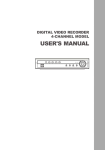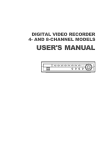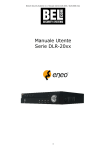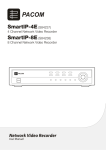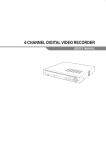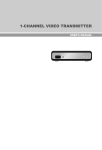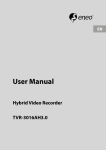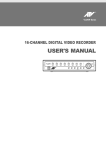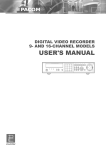Download 8-16 inputs standalone digital video recorder art. 49188
Transcript
8-16 INPUTS STANDALONE DIGITAL VIDEO RECORDER ART. 49188-49186 Please read this manual thoroughly before use and keep it for future reference. Via Don Arrigoni, 5 24020 Rovetta S. Lorenzo (Bergamo) http://www.comelit.it – E mail: [email protected] Digital Video Recorder art. 49186-49188 WARNINGS AND CAUTIONS WARNING TO REDUCE THE RISK OF FIRE OR ELECTRIC SHOCK, DO NOT EXPOSE THIS PRODUCT TO RAIN OR MOISTURE. DO NOT INSERT ANY METALLIC OBJECT THROUGH THE VENTILATION GRILLS OR OTHER OPENINGS ON THE EQUIPMENT. CAUTION Explanation of graphical symbols The lightning flash with arrowhead symbol, within an equilateral triangle, is intended to alert the user to the presence of uninsulated "dangerous voltage" within the product’s enclosure that may be of sufficient magnitude to constitute a risk of electric shock. The exclamation point within an equilateral triangle is intended to alert the user to the presence of important operating and maintenance (servicing) instructions in the literature accompanying the appliance. The user is obliged to inform himself and to conform himself to the national and local rules concerning the monitoring and the audio and video recording. Nobody else will consequently be held responsible for an improper use of this system which could break the laws in force. i User’s Manual FCC COMPLIANCE STATEMENT FCC INFORMATIONS: THIS EQUIPMENT HAS BEEN TESTED AND FOUND TO COMPLY WITH THE LIMITS FOR CLASS A DIGITAL DEVICE, PURSUANT TO PART 15 OF THE FCC RULES. THESE LIMITS ARE DESIGNED TO PROVIDE REASONABLE PROTECTION AGAINST HARMFUL INTERFERENCE IN A RESIDENTIAL INSTALLATION. THIS EQUIPMENT GENERATES, USE AND CAN RADIATE RADIO FREQUENCY ENERGY AND, IF NOT ISTALLED AND USED IN ACCORDANCE WITH THE INSTRUCTIONS, MAY CAUSE HARMFUL INTERFERENCE TO RADIO COMMUNICATIONS. HOWEVER, THERE IS NO GUARANTEE THAT INTERFERENCE WILL NOT OCCUR IN A PARTICULAR INSTALLATION. IF THIS EQUIPMENT DOES CAUSE HARMFUL INTERFERENCE TO RADIO OR TELEVISION RECEPTION, THE USER IS ENCOURAGED TO CORRECT THE INTERFERENCE TO OWN EXPENSES. CAUTION: CHANGES OR MODIFICATIONS NOT EXPRESSLY APPROVED BY THE PARTY RESPONSIBLE FOR COMPLIANCE COULD VOID THE USER’S AUTHORITY TO OPERATE THE EQUIPMENT. THIS CLASS A DIGITAL DEVICE COMPLIES WITH CANADIAN RULES. CE COMPLIANCE STATEMENT WARNING: THIS IS A CLASS A DIGITAL DEVICE. IN A DOMESTIC ENVIRONMENT THIS PRODUCT MAY CAUSE RADIO INTERFERENCE, IN WHICH CASE THE USER MAY BE REQUIRED TO TAKE ADEQUATE MEASURES. ii Digital Video Recorder art. 49186-49188 Important Safeguards 1. Read Instructions All the safety and operating instructions should be read before the appliance is operated. 2. Retain Instructions The safety and operating instructions should be retained for future reference. 3. Cleaning Unplug this equipment from the wall outlet before cleaning it. Do not use liquid aerosol cleaners. Use a damp soft cloth for cleaning. 4. Attachments Never add any attachments and/or equipment without the approval of the manufacturer as such additions may result in the risk of fire, electric shock or other personal injury. 5. Water and/or Moisture Do not use this equipment near water or in contact with water. 6. Ventilation Place this equipment only in an upright position. This equipment has an open-frame Switching Mode Power Supply (SMPS), which can cause a fire or electric shock if anything is inserted through the ventilation holes on the side of the equipment. 7. Placing and Accessories Do not place this equipment on an unstable cart, stand or table. The equipment may fall, causing serious injury to a child or adult, and serious damage to the equipment. 14. Damage requiring Service Unplug this equipment from the wall outlet and refer servicing to qualified service personnel under the following conditions: A. When the power-supply cord or the plug has been damaged. B. If liquid is spilled, or objects have fallen into the equipment. C. If the equipment has been exposed to rain or water. D. If the equipment does not operate normally by following the operating instructions, adjust only those controls that are covered by the operating instructions as an improper adjustment of other controls may result in damage and will often require extensive work by a qualified technician to restore the equipment to its normal operation. E. If the equipment has been dropped, or the cabinet damaged. F. When the equipment exhibits a distinct change in performance – this indicates a need for service. 15. Replacement Parts When replacement parts are required, be sure the service technician has used replacement parts specified by the manufacturer or that have the same characteristics as the original part. Unauthorized substitutions may result in fire, electric shock or other hazards. 16. Safety Check Upon completion of any service or repairs to this equipment, ask the service technician to perform safety checks to determine that the equipment is in proper operating condition. 17. Field Installation This installation should be made by a qualified service person and should conform to all local codes. 18. Correct Batteries Warning: Risk of explosion if battery is replaced by an incorrect type. Dispose of used batteries according to the instructions. This equipment and cart combination should be moved with care. Quick stops, excessive force, and uneven surfaces may cause the equipment and cart combination to overturn. 8. Power Sources This equipment should be operated only from the type of power source indicated on the marking label. If you are not sure of the type of power, please consult your equipment dealer or local power company. 9. Power Cords Operator or installer must remove power and TNT connections before handling the equipment. 10. Lightning For added protection for this equipment during a lightning storm, or when it is left unattended and unused for long periods of time, unplug it from the wall outlet and disconnect the antenna or cable system. This will prevent damage to the equipment due to lightning and power-line surges. 11. Overloading Do not overload wall outlets and extension cords as this can result in the risk of fire or electric shock. 12. Objects and Liquids Never push objects of any kind through openings of this equipment as they may touch dangerous voltage points or short out parts that could result in a fire or electric shock. Never spill liquid of any kind on the equipment. 13. Servicing Do not attempt to service this equipment yourself. Refer all servicing to qualified service personnel. 19. Tmra A manufacturer’s maximum recommended ambient temperature (Tmra) for the equipment must be specified so that the customer and installer may determine a suitable maximum operating environment for the equipment. 20. Elevated Operating Ambient Temperature If installed in a closed or multi-unit rack assembly, the operating ambient temperature of the rack environment may be greater than room ambient. Therefore, consideration should be given to installing the equipment in an environment compatible with the manufacturer’s maximum rated ambient temperature (Tmra). 21. Reduced Air Flow Installation of the equipment in the rack should be such that the amount of airflow required for safe operation of the equipment is not compromised. 22. Mechanical Loading Mounting of the equipment in the rack should be such that a hazardous condition is not caused by uneven mechanical loading. 23. Circuit Overloading Consideration should be given to connection of the equipment to supply circuit and the effect that overloading of circuits might have on over current protection and supply wiring. Appropriate consideration of equipment nameplate ratings should be used when addressing this concern. 24. Reliable Earthing (Grounding) Reliable grounding of rack mounted equipment should be maintained. Particular attention should be given to supply connections other than direct connections to the branch circuit (e.g., use of power strips). WEEE (Waste Electrical & Electronic Equipment) Correct Disposal of This Product (Applicable in the European Union and other European countries with separate collection systems) This marking shown on the product or its literature, indicates that it should not be disposed with other household wastes at the end of its working life. To prevent possible harm to the environment or human health from uncontrolled waste disposal, please separate this from other types of wastes and recycle it responsibly to promote the sustainable reuse of material resources. Household users should contact either the retailer where they purchased this product, or their local government office, for details of where and how they can take this item for environmentally safe recycling. Business users should contact their supplier and check the terms and conditions of the purchase contract. This product should not be mixed with other commercial wastes for disposal. iii User’s Manual iv Digital Video Recorder art. 49186-49188 Table of Contents Chapter 1 — Introduction...................................................................................1 Features .........................................................................................................1 Package Contents ..........................................................................................2 Chapter 2 — Installation & Configuration ..........................................................3 Rear Panel Connectors ..................................................................................3 Front Panel Controls ......................................................................................6 Infrared Remote Control.................................................................................7 Turning on the Power .....................................................................................9 Main Setup ...................................................................................................10 System Setup ...............................................................................................11 Record Setup ...............................................................................................15 Event Setup ..................................................................................................17 Network Setup..............................................................................................21 Camera Setup ..............................................................................................25 Display Setup ...............................................................................................26 Chapter 3 — Operations ..................................................................................28 Live Monitoring .............................................................................................28 Display Menu................................................................................................30 Event Monitoring ..........................................................................................31 Active Cameo Mode .....................................................................................31 PTZ Mode.....................................................................................................31 Recording Video...........................................................................................32 Playing Recorded Video...............................................................................33 Searching Video ...........................................................................................33 Search Filter .................................................................................................35 Go To............................................................................................................38 Clip-copy.......................................................................................................39 WebGuard ....................................................................................................40 Web Monitoring ............................................................................................41 Web Search..................................................................................................42 Appendix ..........................................................................................................44 Factory Default Settings ...............................................................................44 Error Code Notices.......................................................................................46 Troubleshooting............................................................................................47 Specifications ...............................................................................................48 v User’s Manual vi Digital Video Recorder art. 49186-49188 Chapter 1 — Introduction FEATURES Your color digital video recorder (DVR) provides recording capabilities for 8 or 16 camera inputs. It provides exceptional picture quality in both live and playback modes, and offers the following features: 8 or 16 Composite Input Connectors Compatible with Color (NTSC or PAL) and B&W (CCIR and EIA-170) Video Sources Auto Detection for NTSC and PAL Auto Detection for VGA Monitor Records up to 120/100 Images per Second (NTSC/PAL) Continuous Recording in Disk Recycle Mode Records while Playing Back and Transmitting to Remote Site Full Function Infrared Remote Control User-friendly Graphical User Interface (GUI) Menu System Multiple Recording Modes (Time-lapse, Pre-event, Motion and Alarm) Multiple Search Engines (Date/Time, Event, Record Table) Text Input for ATM and POS Alarm Connections Include: Input, Output and Reset Input 2 USB 2.0 Ports Built-in Buzzer Live or Recorded Video Access via Ethernet Self-diagnostics with Automatic Notification including Hard Disk Drive S.M.A.R.T. Protocol NOTE: This manual covers the 8- and 16-channel digital video recorders. The DVRs are identical except for the number of cameras and alarms that can be connected and the number of cameras that can be displayed. For simplicity, the illustrations and descriptions in this manual refer to the 16-camera model. Typical DVR installation 1 User’s Manual PACKAGE CONTENTS The package contains the following: 2 Digital Video Recorder Power Cord USB Mouse Infrared Remote Control and Batteries Rack-mount Kit RAS Software CD and User’s Manual (This document) Digital Video Recorder Power Cord USB Mouse IR Remote Control and Batteries (AAA Type) Rack-mount Kit RAS Software CD and User’s Manual Digital Video Recorder art. 49186-49188 Chapter 2 — Installation & Configuration REAR PANEL CONNECTORS No special tools are required to install the DVR. Refer to the installation manuals for the other components that make up part of your system. Your DVR should be completely installed before proceeding. 16-Channel DVR rear panel Video In Factory Reset Switch Video Out RS-485 Port RS232C Port Network Port Alarm Input/Output Power Connector Your DVR can be used with either NTSC or PAL equipment. NOTE: You cannot mix NTSC and PAL equipment. For example you cannot use a PAL camera and an NTSC monitor. Connecting the Video Input Connect the coaxial cables from the video sources to the BNC Video In connectors. Connecting the Monitor A VGA connector is provided so that you can use a standard, multi-sync computer monitor as your main monitor. Use the cable supplied with your monitor to connect it to the DVR. The VGA monitor is automatically detected when you connect it. NOTE: It is possible that the DVR will not automatically detect a VGA monitor if the monitor does not support the auto detect function. In this case, press and hold the DISPLAY button on the remote control for 5 seconds or longer to switch the video output to VGA out. Pressing and holding the button for 5 seconds or longer again returns to the composite video output mode. 3 User’s Manual If you prefer to use a standard CCTV monitor, connect it to the Video Out connector. NOTE: The DVR does not support simultaneous operation of a CCTV and a VGA monitor. Connecting to the RS232C Port The RS232C port can be used to control PTZ (pan, tilt, zoom) cameras. Connecting Alarms NOTE: To make connections on the Alarm Connector Strip, press and hold the button and insert the wire in the hole below the button. After releasing the button, tug gently on the wire to make certain it is connected. To disconnect a wire, press and hold the button above the wire and pull out the wire. AI 1 to 16 (Alarm-In): You can use external devices to signal the DVR to react to events. Mechanical or electrical switches can be wired to the AI (Alarm-In) and GND (Ground) connectors. The threshold voltage for NC (Normally Closed) is above 4.3V and for NO (Normally Open) is below 0.3V, and it should be stable at least 0.5 seconds to be detected. GND (Ground): Connect the ground side of the alarm input and/or alarm output to a GND connector. NOTE: All the connectors marked GND are common. NC/NO (Normally Closed/Normally Open): Connect the device to the C (Common) and NC (Normally Closed) connectors or C and NO (Normally Open) connectors. NC/NO is a relay output which sinks 2A@125VAC (NC) and 1A@30VDC (NO). ARI (Alarm Reset In): An external signal to the Alarm Reset In can be used to reset both the Alarm Out signal and the DVR’s internal buzzer. Mechanical or electrical switches can be wired to the ARI (Alarm Reset In) and GND (Ground) connectors. The threshold voltage is below 0.3V and should be stable at least 0.5 seconds to be detected. Connect the wires to the ARI (Alarm Reset In) and GND (Ground) connectors. Connector Pin Outs: 4 AI (1 to 16) NC C NO ARI GND Alarm Inputs 1 to 16 Alarm Out (Normally Closed) Common Alarm Out (Normally Open) Alarm Reset In Chassis Ground Digital Video Recorder art. 49186-49188 Connecting to the Network Port The DVR can be networked using the 10/100Mb Ethernet connector. Connect a Cat5 cable with an RJ-45 jack to the DVR connector. The DVR can be networked with a computer for remote monitoring, searching, configuration and software upgrades. See the Network Setup section in this chapter for configuring the Ethernet connections. CAUTION: The network connector is not designed to be connected directly with cable or wire intended for outdoor use. Factory Reset The DVR has a Factory Reset switch to the left of the Alarm Output connector on the rear panel. This switch will only be used on the rare occasions that you want to return all the settings to the original factory settings. CAUTION: When using the Factory Reset, you will lose any settings you have saved. To reset the unit, you will need a straightened paperclip: Turn the DVR off. Poke the straightened paperclip in the unlabeled hole to the left of the Alarm Output connector, and turn the DVR on. Hold the switch for 10 seconds. Release the reset switch. All of the DVR’s settings are now at the original settings it had when it left the factory. Connecting to the RS-485 Port The RS-485 connector can be used to control PTZ (pan, tilt, zoom) cameras. Connect TX+/RX+ or TX-/RX- of the control system to the RX+/TX+ or RX-/TX- (respectively) of the DVR. See the Camera Setup section in this chapter of this manual and the PTZ camera manufacture’s manual for configuring the RS-485 connection. Connector Pin Outs: Master Unit RX+/TX+ → To → RX-/TX- → To → Slave Unit TX+/RX+ TX-/RX- Connecting the Power Cord Connect the AC power cord to the DVR and then to a wall outlet. WARNING: ROUTE POWER CORDS SO THAT THEY ARE NOT A TRIPPING HAZARD. MAKE CERTAIN THE POWER CORD WILL NOT BE PINCHED OR ABRADED BY FURNITURE. DO NOT INSTALL POWER CORDS UNDER RUGS OR CARPET. THE POWER CORD HAS A GROUNDING PIN. IF YOUR POWER OUTLET DOES NOT HAVE A GROUNDING PIN RECEPTACLE, DO NOT MODIFY THE PLUG. DO NOT OVERLOAD THE CIRCUIT BY PLUGGING TOO MANY DEVICES IN TO ONE CIRCUIT. 5 User’s Manual FRONT PANEL CONTROLS Alarm LED HDD LED LAN LED Power LED USB Port Alarm LED The Alarm LED is lit when alarm output or internal buzzer is activated. HDD LED The HDD LED flickers when the DVR is recording or searching video on the hard disk drive. LAN LED The LAN LED is lit when the unit is connected to a network via Ethernet. Power LED The Power LED is lit when the unit is On. USB Port Connect the supplied USB mouse to one of the ports. The USB mouse will be used to access many of the DVR’s functions. A USB flash drive can be connected to make video clip copies or for system upgrades. A USB to Serial converter can be connected to the USB port. NOTE: The infrared sensor on the DVR is just to the right of the Power LED. Make certain that nothing blocks the sensor, or the remote control will not function properly. 6 Digital Video Recorder art. 49186-49188 INFRARED REMOTE CONTROL ID Button DISPLAY Button SEQUENCE Button FREEZE Button ALARM Button CAMERA Buttons PTZ Control Buttons (FOCUS, PRESET, ZOOM) MENU Button PTZ Mode Button Arrow Buttons Enter Button ZOOM Mode Button PLAYBACK Buttons (Stop, Pause, Play, RW, FF, Previous, Next) ID Button If a DVR System ID is set to 0, the infrared remote control will control that DVR without any additional entries. (Refer to the Main Setup section in this chapter for further information on setting the System ID.) If the DVR system ID is 1 to 16, you must to press the ID button on the remote control followed by the number button (1 to 16) in order to control that DVR. If two or more DVRs have the same ID, those DVRs will react to the infrared remote control at the same time. DISPLAY Button Pressing the DISPLAY button toggles between different display formats. The available formats are: full, 4x4, 3x3, 2x2 and PIP. When the DVR does not detect a VGA monitor automatically, pressing and holding the button for 5 seconds or longer will toggle the video output between the composite video output and VGA out. SEQUENCE Button When in the Live Monitoring mode, pressing the SEQUENCE button displays live channels sequentially. 7 User’s Manual FREEZE Button Pressing the FREEZE button freezes the current live screen. ALARM Button Pressing the ALARM button resets the DVR’s outputs including the internal buzzer during an alarm. CAMERA Buttons (1 to 16) Pressing the individual camera buttons will cause the selected camera to display full screen. Buttons 1 to 9 are also used to enter passwords. PTZ Control Buttons While in the PTZ mode, the FOCUS buttons are used for Near Focus and Far Focus, the PRESET buttons are used to save Presets and load a Preset View, and the ZOOM buttons are used to Zoom In and Zoom Out. MENU Button In the Live Monitoring mode and Search mode, pressing the MENU button displays the menu icons at the top of the screen. Pressing the button also hides the menu icons. During menu setup, pressing the button closes the current menu or setup dialog box. PTZ Mode Button Pressing the PTZ button enters the PTZ (Pan/Tilt/Zoom) mode which allows you to control properly configured cameras. Up, Down, Left, Right Arrow Buttons These buttons are used to navigate through menus and items displayed in the Live Monitoring or Search screens. They are also used to navigate through menus and GUI during the system setup. You also can use them to change numbers by highlighting a number in a menu and using the Up and Down arrow buttons to increase or decrease the number’s value. The arrow buttons are also used to control Pan and Tilt when in the PTZ mode. When in the PIP display format, pressing the Up and Down arrow buttons moves the position of the small screen counter-clockwise and clockwise. Pressing the Left and Right buttons moves through screen pages in the Live Monitoring mode and Search mode. Enter Button The (Enter) button selects a highlighted item or completes an entry that you have made during system setup. This button is also used to enter the Cameo mode in the Live Monitoring mode or Search mode. ZOOM Mode Button Pressing the ZOOM button zooms the current image on the screen. A PIP with a rectangle temporarily displays showing what area of the screen has been enlarged. You can use the arrow buttons to move the rectangle to another area. 8 Digital Video Recorder art. 49186-49188 PLAYBACK Buttons Stop: Stops playback and enters the Live Monitoring mode. Pause: Pauses the video. displays on the screen when in the Pause mode. Play: Plays back images at regular speed. The screen displays when the DVR is playing back video. RW (Rewind): Plays video backward at high speed. Pressing the button again toggles the playback speed from , and . , and displays on the screen respectively. FF (Fast Forward): Plays video forward at high speed. Pressing the button again toggles the playback speed from , and . , and displays on the screen respectively. Previous: Goes to the previous image. Next: Goes to the next image. In the Live Monitoring mode, pressing any playback button enters to the Search mode. TURNING ON THE POWER Connecting the power cord to the DVR turns on the unit. The unit will take approximately 30 seconds to initialize. As soon as the DVR’s initialization process completes, you might have the DVR’s internal buzzer sound if not all cameras (16 and 8 cameras for 16- and 8-channel DVR respectively) are installed to the DVR because the DVR is set to use all camera channels by default. To turn the internal buzzer off, press the ALARM button on the remote control, or move the mouse pointer to the top of the screen and click the (Alarm Off) icon. Before using your DVR for the first time, you will want to establish the initial settings. The following describes how to use the remote control and mouse in the setup screen. Take a minute to review the descriptions. Remote Control In Live Monitoring mode, press the MENU button to display the menu icons at the top To enter the setup of the screen. Select the (Setup) icon by screen… pressing the (Enter) button. Move to the desired item by pressing the arrow buttons ( , , , ) and select To select items… it by pressing the button. Select the desired item and press the Up and Down arrow buttons ( , ) to increase To change values… or decrease the values and then press the button to complete the entry. Select the desired item and press the button to displays a virtual keyboard. Move To enter characters… to the desired character by pressing the arrow buttons, and press the button. Mouse In the Live Monitoring mode, move the mouse pointer to the top of the screen to display hidden menu icons. Click the (Setup) icon with the left button. Click the desired item with the left button. Select the desired item with the left button and roll the mouse wheel up and down to increase or decrease the values. Select the desired item with the left button to displays a virtual keyboard. Click the desired character with the left button. NOTE: For simplicity, most of the operation explanations in this manual are based on using the Remote Control. While setting up the DVR, there will be many opportunities to enter names and titles. When making these entries, a Virtual Keyboard will appear. Use the arrow buttons on the remote control to highlight the character you want in the name or title and press the button. That character appears in the title bar and the cursor moves to the next position. Selecting toggles between the upper and lower case keyboards, backspaces, and deletes entered characters. You can use up to 31 characters including spaces in your title. 9 User’s Manual MAIN SETUP The Main Setup screen gives you to access to all the DVR’s setup screens. Your DVR can be set up using various screens and dialog boxes. Throughout the screens you will see . Selecting the and pressing the button on the remote control gives you the opportunity to reset that screen to its default settings. You can save your changes by selecting the Save button and pressing the button. Selecting the Cancel button exits the screen without saving the changes. To enter the Main Setup screen, press the MENU button on the remote control. Select the button. The Login screen appears. of the screen by pressing the (Setup) icon at the top Select a User and enter the password by pressing the appropriate combination of Camera number buttons on the remote control and select the OK button. The following Main Setup screen appears. There is no default password when logging in the admin user for the first time. NOTE: Setting up a password is strongly recommended to ensure secure management of the system. NOTE: To enter a password by using the mouse, click the instructions above for using the virtual keyboard. button, and a virtual keyboard displays. See To log the user out of the system, press the MENU button on the remote control or move the mouse pointer to the top of the screen and select the icon. The Logout screen displays asking you to confirm whether or not you want to log out the current user. 10 Digital Video Recorder art. 49186-49188 SYSTEM SETUP System Settings (SYSTEM System Tab) System ID: Set the system ID. Use the Up and Down arrow buttons or scroll the mouse wheel to increase or decrease the number. NOTE: It is possible to have multiple DVRs with the same System ID in the same area. In this case, all DVRs with the same System ID will be controlled at the same time when using the infrared remote control for that ID number. Language: Select the desired language. Version: Displays the software version of the DVR. To upgrade the software, connect a USB flash drive containing the upgrade package file (.rui) to the DVR. Selecting Upgrade… displays the Upgrade screen. Select the desired upgrade file and press the button. The system restarts automatically after completing the upgrade. Setup: Imports saved DVR settings or exports the current DVR settings. Import... – To import saved DVR settings, connect a USB flash drive containing the setup file to the DVR and select the desired setup file. Selecting Include Network Setup changes the network settings. Export... – To save the current DVR settings in .dat file format, connect a USB flash drive to the DVR and enter a file name for the settings. 11 User’s Manual NOTE: Even after changing the DVR settings by importing saved settings, the time-related settings (Date/Time, Time Zone and Daylight Saving Time) will NOT be changed. CAUTION: The USB device must be FAT16 or FAT32 format. Show System Log…: Displays the system logs (up to 5,000 from the latest). The column for system activities of remote sites. icon will be displayed in the last Log Message Log Message Log Message Boot Up Shutdown Restart Upgrade (Local) Upgrade Failure (Local) Time Change (Local) Time Zone Change (Local) Time Sync Time Sync Failure Login : (Local/Remote) Logout : (Local/Remote) Setup Begin Setup End Setup Imported Setup Import Fail Setup Exported Setup Export Fail Setup Export Cancel Schedule On Schedule Off Clear All Data (Local) Format Disk DISK FULL Auto Deletion DISK# BAD Search Begin (Local/Remote) Search End (Local/Remote) Clip-Copy Begin (Local/Remote) Clip-Copy End (Local/Remote) Clip-Copy Cancel (Local/Remote) Clip-Copy Failure (Local/Remote) Clip-Copy User: Clip-Copy From: Clip-Copy To: Clip-Copy Duration of Video: Clip-Copy Camera: User Management…: Registers users and changes the password, and assign authority levels to the group. Selecting + User… allows you to enter the user name and password. Selecting allows you to delete a User Name or an entire Group. Selecting the Operator column allows you to assign authority levels to the group. NOTE: Up to five Users can be registered to the Operator group. NOTE: To enter a password by using the mouse, click the button, and a virtual keyboard displays. See the Turning On the Power section above for using the virtual keyboard. CAUTION: Write down the new password and save it in a secure place. If the password is forgotten, the unit must be reset using the Factory Reset button and all data settings will be lost. 12 Digital Video Recorder art. 49186-49188 NOTE: Selecting the Authority box toggles between all authority levels being turned On an Off. Selecting the individual authority level boxes toggles between that authority level being turned On and Off. Shut Down – The user can shut the system down on a local system. Upgrade – The user can upgrade the software on a local system or a PC running RAS. System Time Change – The user can change the system date and time on a local system or a PC running RAS. Data Clear – The user can clear all video data or format disks on a local system or a PC running RAS. Setup – The user without Setup authority cannot establish any system settings excluding system shutdown and logout on a local system or a PC running RAS. Color Control – The user can control brightness, contrast, hue and saturation for cameras on a local system or a PC running RAS. PTZ Control – The user can control the PTZ camera on a local system or a PC running RAS. Alarm-Out Control – The user can reset the DVR’s outputs including the internal buzzer during an alarm by pressing the ALARM button on a local system or alarm-out control button on a PC running RAS. Record Setup – The user can establish all Record settings on a local system or a PC running RAS. Search – The user can access the Search mode on a local system or a PC running RAS. Clip-Copy – The user can copy video clips on a local system or a PC running RAS, and save video data in an AVI, bitmap or JPEG file format. System Shutdown: Shuts the system down. Date/Time Settings (SYSTEM Date/Time Tab) Date: Set the system date, and select the date format. Time: Set the system time, and select the time format. Time Zone: Select your time zone. Enable Daylight Saving Time: Selecting the box sets the system to enable daylight saving time. Time Sync…: Set up the time synchronization between the DVR and standard time servers that are available in most time zones and countries, or between the DVR and another DVR. 13 User’s Manual Automatic Sync – Selecting the box enables you to set up the automatic time synchronization. Time Server – Enter the IP address or domain name of the time server. Interval – Set the time interval for synchronization. Last Sync-Time – Displays the last time the DVR was synchronized with the time server. Run as Server – Selecting the box sets the DVR you are setting up to run as a time server. Holiday…: Set up holidays. – Displays the current date. Set the date to add for holiday. – Deletes the selected date from holidays. NOTE: Holidays that do not fall on the same date each year should be updated once the current year’s holiday has passed. NOTE: The clock will not start running until you have selecting the Save button. Storage Settings (SYSTEM Storage Tab) Capacity: Displays the capacity of the storage drive. Status: Displays status of the DVR’s storage devices. Selecting the column for the desired device displays the Disk Bad, Temperature and S.M.A.R.T. information. 14 Digital Video Recorder art. 49186-49188 Disk Bad – Displays the damage status of the storage drive. (Not Formatted (The device is not formatted), Good (%) (The device is working properly though some portion (%) of the storage is damaged.) or Bad (More than 90% of the storage is damaged.)) Temperature – Displays the temperature of the storage drive. (N/A (The DVR cannot read the temperature.), Good (The temperature is normal.) or Bad (The temperature is 70oC (158oF) or higher.)) S.M.A.R.T. – Displays S.M.A.R.T. information of the storage. (Good (The storage condition is normal.), Bad (Data cannot be written on or read from the storage drive.) or N/A (The S.M.A.R.T. monitoring is not working or supported.)) NOTE: When the S.M.A.R.T. displays Bad, the screen displays a message box. Once the message box appears, replacing the hard disk drive is recommended, usually within 24 hours. Information: Displays whether the device is being used or not. “Other” indicates the device has been used for another DVR. Selecting the column for the desired device displays the time information about recorded data. Format: Displays whether the device is used for recording (Record) or not (Not Using). Selecting the column for the desired device allows you to format the device for recording. When selecting Use As – Not Using and then Format, the device will not be used for recording. Recorded Data: Displays the time information about recorded data on the drive. Selecting Clear All Data… will clear all video data except the system log. RECORD SETUP General Settings (RECORD General Tab) 15 User’s Manual Recycle When Disk Full: Selecting this box records over the oldest video data once all available storage space has been used. When the box is not checked, the DVR stops recording once all available storage has been used. Resolution: Select the recording resolution. NOTE: The total ips of all camera channels will be limited to 60 ips (50 ips PAL) when set to High resolution and 30 ips (25 ips PAL) when set to Very High resolution. NOTE: When set to High or Very High resolution, the maximum recording speed of each camera channel decreases by half. However the maximum recording speed of 30 ips (25 ips PAL) will be maintained if the number of cameras that are turned On is two or less. 0 ─ No. of cameras set to On and High or Very High resolution 1 2 3 to 16 30 ips (25 ips PAL) 30 ips (25 ips PAL) 15 ips (12.5 ips PAL) Auto Deletion: Adjust the length of time recorded data will be kept by using the slide bar. Selecting Never will disable the Auto Deletion function. The DVR automatically deletes video recorded earlier than the user-defined period under three conditions: at midnight, whenever the system reboots or whenever the user changes the Auto Deletion settings. Schedule Settings (RECORD Schedule Tab) The DVR provides two recording schedule modes: Basic and Advanced. The Basic schedule mode allows you to set recording settings for all camera channels at one time. The Advanced schedule mode allows you to set recording settings for each camera channel. Setting up the Basic Schedule Mode… Schedule Type: Select the Basic schedule mode. Record Mode: Select the desired recording mode. ( : Time (Time-lapse) recording, : Event recording, : Time & Event recording) Record Schedule: Set the time range for recording schedule. Time Record ips: Set the images per second for Time recording. Time Record Quality: Set the recorded image quality for Time recording. Event Record ips: Set the images per second for the pre- and post-event recording. Event Record Quality: Set the recorded image quality the pre- and post-event recording. Event Record Dwell: Set the length of time you would like to record for the associated event. Pre-Event Record Dwell: Set the length of time you would like to record prior to the associated event. Selecting None will disable the pre-event recording function. 16 Digital Video Recorder art. 49186-49188 Setting up the Advanced Schedule Mode… Schedule Type: Select the Advanced schedule mode. Pre-Event Record: Selecting the Setup… button allows you to set up the pre-event recording by setting the ips, Quality and Dwell. Selecting None will disable the pre-event recording function. Post-Event Record Dwell: Set the length of time you would like to record for the associated event. Add Schedule…: Adds a schedule item. Up to 20 schedules can be registered. No. – Indicates a schedule number. The higher the number, the higher its priority. Day – Select the days that the recording will take place. Range – Set the time range that the recording will take place. Mode – Select the recording mode. ( : Time (Time-lapse) recording, : Event recording, : Time & Event recording) Channels – Select which cameras will be recorded. Settings – Set the ips, Quality and Dwell of the recording for the selected recording mode in the Mode column. If you do not set the Settings column, the DVR will follow the default settings. See below for details. – Deletes the recording settings. Default: Set the default settings of ips, Quality and Dwell for Time and Event recording. EVENT SETUP 17 User’s Manual Motion Event Settings (EVENT Motion Tab) No.: Your DVR has built-in motion detection. Selecting the box turns the motion detection On and Off for each camera. Sensitivity: Set the DVR’s sensitivity to motion for Daytime and Nighttime independently from 1 (the least sensitive) to 5 (the most sensitive). Zone: Define the area of the image where you want to detect motion; e.g., a doorway. The Motion Detection Zone screen is laid over the video from the selected camera. You can set up motion zones one block at a time in groups of eight individual block groups. A block group is positioned within the image area using the arrow buttons on the remote control, and individual blocks within the block groups are selected or cleared using the camera buttons. You can set up motion detection zones by selecting or clearing blocks. You can select or clear eight individual blocks in a group at a time, and individual blocks within the group are selected or cleared by using the camera buttons on button on the remote control or clicking the right mouse button displays the the remote control. Pressing the menu screen. Each item in the menu has the following functions; Select/Select All – Activates highlighted blocks or all blocks to detect motion. Clear/Clear All – Deactivates highlighted blocks so that they will not detect motion. Reverse/Reverse All – Activates inactive highlighted blocks or all inactive blocks and deactivates active highlighted blocks or all active blocks. OK – Accepts changes and closes Zone setup. Cancel – Exits Zone setup without saving changes. NOTE: You can select the block groups to be selected or cleared by using the mouse. Place the mouse pointer where you want to start the line. Hold down the left mouse button and drag the pointer to where you want to end of the line. Release the mouse button and a group of blocks appears along the line you drew. You can draw lines around shapes by repeating this process. Min. Blocks: Set the minimum number of detection blocks that must be activated to trigger a motion alarm for Daytime and Nighttime independently. 18 Digital Video Recorder art. 49186-49188 Actions: Set up actions the DVR will take whenever it detects motions for each camera. Alarm-Out – Select the alarm-out signals (Alarm-Out and Beep) to be associated with the camera. The DVR will alert you of the event by activating an external alarm or internal buzzer if motion is detected on the selected camera. Notify – Select Mail if you want to send an e-mail to the address set during NETWORK – Mail setup when the DVR detects motion on the selected camera. PTZ – Select the preset position, where you want PTZ cameras to move to when the DVR detects motion on the selected camera. NOTE: For the Notify action to work, the Mail should be enabled in the NETWORK – Mail setup. Motion Ignoring Interval: Set the motion ignoring dwell time. You can control excessive event logging and remote notification of motion detected after the motion dwell time by adjusting the motion ignoring dwell intervals. The DVR will not log and notify motion events occurred during the preset interval range. The recording for motion events will not be affected by the Motion Ignoring function. Daytime Setup…: Select the button and set the Daytime range. The DVR will consider the remaining time range as the nighttime. Alarm-In Event Settings (EVENT Alarm-In Tab) No.: Selecting the box toggles each alarm input On and Off. Title: Change the name of all or each alarm input. Type: Set each alarm input as NO (Normally open) or NC (Normally closed). Actions: Set up actions the DVR will take whenever it senses an input on one of its alarm input connectors. 19 User’s Manual Alarm-Out – Select the alarm-out signals (Alarm-Out and Beep) to be associated with the alarm input. The DVR will alert you of the event by activating an external alarm or internal buzzer when an input is detected on the selected alarm input. Notify – Select Mail if you want to send an e-mail to the address set during NETWORK – Mail setup when the DVR detects an input on the selected alarm input. PTZ – Select the preset position, where you want PTZ cameras to move to setup when the DVR detects an input on the selected alarm input. NOTE: For the Notify action to work, the Mail should be enabled in the NETWORK – Mail setup. System Event Settings (EVENT System Tab) Settings: Set up the DVR to run self-diagnostics. System – Select the interval that you want the DVR to run self-diagnostics on the system. Check Recording – Selecting the column allow you to set up the check recording schedule by selecting Schedule On. Selecting allows you to add a check recording schedule by setting the day, time range and interval that you want the DVR to run self-diagnostics on the recorder. Selecting allows you to delete a check recording schedule. Check Alarm-In – Selecting the column allow you to change interval the DVR to run self-diagnostics on alarm inputs. Disk Almost Full – Select the percentage level of disk usage at which you want the DVR to trigger an alert. Disk Bad – Select percentage level of bad disk sectors at which you want the DVR to trigger an alert. Disk Temperature – Set the temperature threshold and ºC (Celsius) or ºF (Fahrenheit). If the temperature of hard disk drive exceeds the defined threshold, the system triggers an alert. 20 Digital Video Recorder art. 49186-49188 Actions: Set up actions the DVR will take whenever it detects system events. System events can sound the DVR’s internal buzzer and/or notify a number of different devices. NOTE: The Beep action cannot be set to System event. NOTE: For the Notify action to work, the Mail should be enabled in the NETWORK – Mail setup. NETWORK SETUP General Settings (NETWORK General Tab) Transfer Speed: Set the transfer speed, and select the unit of measure for the transfer speed between bps (bit per second) and ips (image per second). Quality: Select the quality of the transferred image. NOTE: The local recording speed might be affected by various network bandwidth (Transfer Speed) conditions. NOTE: The higher Quality settings require higher Transfer Speed settings. The transfer speed you set is the maximum speed. Depending on the network environment, this speed may not be achieved. Enable WebGuard Service: Selecting the box turns the WebGuard service On. Select the port number used when accessing WebGuard. See Chapter 3 – WebGuard for details. 21 User’s Manual Network Settings (NETWORK Network Tab) Type: Select the type of network configuration from: Manual, DHCP and ADSL (with PPPoE). Manual – You can select Manual when using a static IP address for network connection. Set up LAN parameters manually. Set the numbers of the IP Address, Gateway and Subnet Mask. DHCP – You can select DHCP when the DVR is networked through DHCP (Dynamic Host Configuration Protocol). The DVR reads the IP address from DHCP network when selecting the Save button. ADSL – You can select ADSL (with PPPoE) when the DVR is networked through ADSL. Enter the ID and password for ADSL connection, and the DVR receives the IP address when selecting the Save button. NOTE: Ask your network provider for your network connection type and connection information. NOTE: If the DVR is configured for DHCP or ADSL, the IP address of the DVR might change whenever the unit is turned on. If you want to use the DVRNS function, you will need to get the IP Address of the DNS Server from the Internet service provider. DNS Server: Set the DNS server IP address obtained from your network administrator. If you set up the DNS Server, the domain name of the DVRNS server or SMTP server instead of the IP address can be used during DVRNS Server or Mail setup. Port Number Setup…: Set the port number of each remote software related program. NOTE: You will need to get the appropriate Port Numbers for each remote software related program from your network administrator. Do NOT use the same port number for two different programs, otherwise, the DVR cannot be connected with the PC running RAS or WebGuard. NOTE: The system restarts automatically after changing the port settings. CAUTION: When changing the port settings, you must change the port settings on the PC running RAS or WebGuard. 22 Digital Video Recorder art. 49186-49188 DVRNS Settings (NETWORK DVRNS Tab) NOTE: The DVRNS (DVR Name Service) allows you to connect to the DVR remotely with the dynamic IP address or the domain name. When using this feature, you can access your DVR remotely by using the DVR name instead of IP address. To use the DVRNS feature, the DVR should be registered on the DVRNS server, and the DVRNS server settings on your DVR must match the settings on the registered DVRNS server. Any changes to the DVRNS server might cause improper operation. NOTE: When Network settings have been changed, set up the DVRNS after saving your Network changes by selecting the Save button. Enable DVR Name Service: Selecting the box enables the DVR Name Service function. You will only be able to change the settings if Enable DVR Name Service is enabled. DVRNS Server: Enter the IP address or domain name of the DVRNS server. NOTE: You will need to get the IP address or domain name of the DVRNS server from your network administrator. You can use the domain name instead of IP address if you set up the DNS server during Network setup. Port: Set the port number of the DVRNS server. Enable NAT: Check the box when using NAT. When using a NAT (Network Address Translation) device, refer to the NAT manufacturer’s instructions for the proper network settings. DVR Name: Enter the DVR name to be registered on the DVRNS server. Check whether or not the name you entered is available by selecting the Check button. NOTE: The DVR name you entered should be checked by selecting the Check button, otherwise the DVRNS changes will not be saved. When no name is entered or a name is already registered on the DVRNS server, an error message displays. Help Desk: Selecting the Save button registers the DVR on the DVRNS server. Proper DVRNS settings will cause the help desk information of the DVRNS server to display 23 User’s Manual Mail Settings (NETWORK Mail Tab) Enable: The DVR can be set up to send an e-mail when an event occurs. Selecting the box enables the Mail function. You will only be able to change the settings if Mail is enabled. SMTP Server: Set the SMTP server IP address or domain name obtained from your system administrator. NOTE: You will need to get the IP address or domain name of the SMTP server from your network administrator. You can use the domain name instead of IP address if you set up the DNS server during Network setup. Port: Set the SMTP server port number obtained from your system administrator. Enable SSL/TLS: Check the box when sending an e-mail via an SMTP server requiring SSL (Secure Sockets Layer) authentication. Authentication: Select the button if the SMTP server needs authentication, and set up the Authentication by selecting the Use box and entering the user ID and password. Sender/Recipient: Enter the sender’s/recipient’s e-mail address. The e-mail address must include the “@” character to be a valid address. 24 Digital Video Recorder art. 49186-49188 CAMERA SETUP Camera Settings No.: Selecting the box toggles all or each camera On and Off. Title: Change the name of all or each camera. PTZ Model: Select the PTZ device you wish to configure from the list. ID: Set the PTZ ID of each camera. PTZ Port: Select the port to communicate with PTZ cameras. Setup…: Select the button and set the port’s setting according to the PTZ device manufacturer’s instructions. 25 User’s Manual DISPLAY SETUP OSD Settings (DISPLAY OSD Tab) Status/Camera: Check each OSD item box to turn it On or Off. Remote Control – The icon displays when the DVR can be controlled using the infrared remote control. Zoom – The icon displays on the enlarged video. Network – The icon displays when the unit is connected to a network via Ethernet. Freeze & Sequence – The icon displays while in the Freeze mode, and the icon displays while in the Sequence mode. Screen Group – The screen group number displays when the DVR is in other than the 4x4 display mode for the 16-channel DVR and 3x3 mode for the 8-channel DVR. Free Space – The icon displays when the DVR is in the Recycle mode. The percentage of available storage space displays when the DVR is not in the Recycle mode. Date/Time – The current date and time information displays. User Name – The name of the current user logged in displays. Camera No. – The camera number displays in the top-left corner of each camera screen. Camera Title – The camera title displays in the top-left corner of each camera screen. Record – The record related icons display on each camera screen. PTZ – The icon displays on each PTZ camera screen with PTZ capabilities. Transparency: Adjust the transparency of the setup screens by using the slide bar. OSD Margin…: Set the Horizontal and Vertical margins so that text and icons will display within the edges of the monitor. 26 Digital Video Recorder art. 49186-49188 Main Monitor Settings (DISPLAY Main Monitor Tab) Sequence – Mode: Select the sequence mode between Full Sequence and Cameo Sequence. (8- and 16-channel Model Only) Selecting the Sequence menu icon at the top of the screen or pressing the SEQUENCE button on the remote control causes the DVR to sequence cameras. The DVR can sequence cameras in two modes: “Full” and “Cameo.” In the Full mode, the DVR sequences through the cameras with predefined screen layouts. In the Cameo mode, the bottom right window of a multi-screen format sequences through the cameras. See Chapter 3 – Live Monitoring for details. NOTE: You can define the screen layout in a variety of formats and set the DVR to sequence through the different screen layouts (pages) so that all the cameras will be displayed. You also can set up the DVR to display one camera or a group of cameras all the time while cycling through the remaining cameras in a “cameo” window. This can be done with one camera displayed full screen while displaying the cameo window as a PIP (picture-in-picture), or displaying the cameras in a grid pattern with the bottom right window as the cameo. NOTE: Sequence cannot be used in the 4x4 display mode of the 16-channel DVR or 3x3 mode of the 8-channel DVR. Sequence – Interval: Select the display dwell time of sequence monitoring. Event Monitoring On: Selecting the box turns the Event Monitoring On. When it is On, the DVR will display the camera associated with the event when an event occurs. See Chapter 3 – Live Monitoring for details. 27 User’s Manual Chapter 3 — Operations NOTE: This chapter assumes your DVR has been installed and configured. If it has not, please refer to Chapter 2. LIVE MONITORING As soon as the DVR completes its initialization process, it will begin displaying live video on the attached monitor. The default mode is to display all cameras at once. Pressing any camera button on the remote control will cause that camera to display full screen. The DVR continues displaying live video until the user enters another mode. Press the MENU button on the remote control, and the following menu icons display at the top of the screen. Pressing the MENU button again hides the menu icons. You can navigate through menus and items by pressing the arrow buttons on the remote control. Freeze Sequence Camera Menu Alarm Off Setup Search Mode Login/Logout NOTE: The menu icons also can be displayed by moving the mouse pointer to the top of the screen. Freeze Selecting the (Freeze) icon will freeze the current image on the screen until you select Freeze again. It is the same as pressing the FREEZE button on the remote control. Selecting the icon again exits the Freeze mode. While in the Freeze mode, the icon displays in bottom-left corner if Freeze is selected in the Display setup screen (OSD tab). Sequence Selecting the (Sequence) icon causes the cameras to display sequentially. It is the same as pressing the SEQUENCE button on the remote control. When in one of the multiview formats, selecting Sequence will cause the DVR to go through predefined screen layouts (Full Sequence). Or, the bottom, right screen will display live cameras sequentially (Cameo Sequence). For example, if you select the icon in the 2x2 format, the 16-channel DVR changes pages as follows: Full Sequence Cameo Sequence Selecting another display mode or selecting the icon again exits the Sequence mode. While in the Sequence mode, the icon displays in bottom-left corner if Sequence is selected in the Display setup screen (OSD tab). 28 Digital Video Recorder art. 49186-49188 NOTE: Full Sequence for the full sequence monitoring and the Cameo Sequence for the cameo sequence monitoring should be selected in the Display setup screen (Main Monitor tab). Camera Menu Selecting the (Camera Menu) icon displays the following Camera Menu. PTZ: Selecting PTZ and choosing the camera number allows you to control the selected camera as long as it has Pan, Tilt and Zoom capabilities. Selecting PTZ is the same as pressing the PTZ button on the remote control. See the following PTZ Mode section for details. Zoom: Selecting Zoom and choosing the camera number zooms the current image of the selected camera on the screen. Selecting Zoom is the same as pressing the ZOOM button on the remote control. For a few seconds after selecting Zoom, a PIP displays. Inside the PIP, a rectangle shows the area that is enlarged. You can move the rectangle button on the remote control enlarges the area. around using the arrow buttons on the remote control. Pressing the Selecting the (Exit) icon at the top of the screen by pressing the MENU button on the remote control exits the Zoom mode. You also can exit the Zoom mode by pressing the ZOOM button on the remote control. While in the Zoom mode, the icon displays in bottom-left corner if Zoom is selected in the Display setup screen (OSD tab). Color Control: Selecting Color Control and choosing the camera number displays an image adjustment dialog. Selecting Color Control and choosing the camera number is the same as pressing and holding a camera button on the remote control for a few seconds. You can control brightness, contrast, hue and saturation for each camera. NOTE: It is important that cameras and monitors are correctly installed and adjusted prior to making any image adjustments using the DVR’s controls. NOTE: Any image adjustments you make will be applied to both the live video on the monitors and the recorded video. NOTE: The Camera Menu also can be displayed by clicking the right mouse button on each camera screen. Edit Group: Supports the active cameo function. Select Edit Group and choose a camera that you want to change display position (e.g., Camera A). Then, click the right mouse button to display the menu. If you choose another camera in the menu (e.g., Camera B), the screen displays Camera B instead of Camera A. Clicking the right mouse button and selecting Exit Group Edit in the menu exits the Active Cameo mode. See the following Active Cameo Mode section for details. Alarm Off Selecting the (Alarm Off) icon resets the DVR’s outputs including the internal buzzer during an alarm. Selecting the icon is the same as pressing the ALARM button on the remote control. Setup Selecting the (Setup) icon enters the Main Setup screen. Search Mode Selecting the (Search Mode) icon exits the Live Monitoring mode and enters the Search mode. 29 User’s Manual Login/Logout Selecting the icon accesses the Login screen, and you will be asked to select a User and enter the password to log icon displays the Logout screen asking you to confirm whether or not you wan to log into the system. Selecting the out the current user. DISPLAY MENU In the Live Monitoring mode or Search mode, moving the mouse pointer to the left edge of the screen displays the following Display menu icons. Full Screen PIP 2x2 3x3 4x4 Previous Group Next Group OSD Full Screen Selecting the (Full Screen) icon displays the selected camera full screen. Selecting the icon and choosing the camera number is the same as pressing the individual camera buttons on the remote control or clicking the left mouse button on a camera image when in one of the multiview formats (i.e., 2x2, 3x3 or 4x4). Clicking the left mouse button on the screen again returns to the previous display mode. PIP, 2x2, 3x3, 4x4 Selecting the , , or (PIP, 2x2, 3x3 or 4x4) icon displays the cameras in the selected multiview screen mode (PIP, 2x2, 3x3 or 4x4). Selecting each display mode is the same as pressing the DISPLAY button on the remote control or scrolling the mouse wheel up and down when in one of the multiview formats (i.e., 2x2, 3x3 or 4x4). NOTE: The PIP display mode will not be supported in the Search mode. You can change the location of the PIP (Picture-in-Picture) counterclockwise or clockwise by pressing the Up and Down arrow buttons on the remote control. To change its location and size by using the mouse, select the PIP and then click the right mouse button to display the following menu. Select the options you want. Previous Group, Next Group Selecting the or (Previous Group or Next Group) icon moves to the previous or next page. Selecting the icon is the same as pressing the Left or Right buttons on the remote control. OSD Selecting the 30 (OSD) icon toggles OSD On and Off. or Digital Video Recorder art. 49186-49188 EVENT MONITORING When an event occurs, the DVR will display the camera associated with that event if Event Monitoring On is selected in the Display setup screen (OSD tab). How the cameras are displayed depends on the number of cameras associated with the event. If one camera is associated with the event, the DVR will display that camera full screen. If two to four cameras are associated with the event, the DVR will display the cameras on a 2x2 screen. If five to nine cameras are associated with the event, the DVR will display the cameras on a 3x3 screen. If 10 or more cameras are associated with the event, the DVR will display the cameras on a 4x4 screen. Event monitoring lasts for the dwell time set for event recording. After the dwell time has elapsed, the monitor returns to the previous screen unless another event has occurred. If you want to return to the live monitoring mode before the dwell time has elapsed, press the DISPLAY button or one of the camera buttons on the remote control. ACTIVE CAMEO MODE You can enter the Active Cameo mode by pressing the button on the remote control while in any multiview format. A yellow outline surrounding the video indicates the active cameo, and pressing the arrow buttons moves the active cameo. Pressing the button while in the Active Cameo mode exits the Active Cameo mode. You also can exit the (Exit) icon at the top of the screen displayed by moving the mouse pointer to Active Cameo mode by selecting the the top of the screen. The active cameo mode will remains in effect for 15 seconds if there is no further operation. In active cameo mode, press the camera button on the remote control for the camera you want displayed as active cameo. After setting the camera number to active cameo, the DVR moves the active cameo to the next cameo. You can use this method to change the screen layout in this way. PTZ MODE In the Live Monitoring mode, press the MENU button on the remote control or move the mouse pointer to the top of the screen to display the (Camera Menu) icon on the screen. Selecting PTZ and choosing the camera number from the Camera Menu enters the PTZ mode. Only camera numbers that are set up for PTZ control during Camera setup can be selected in the list. To exit the PTZ mode, select the (Exit) icon at the top of the screen displayed by pressing the MENU button while in the PTZ mode. You also can enter the PTZ mode by pressing the PTZ button and selecting the camera button on the remote control and exit the PTZ mode by pressing the button again. While in the PTZ mode, icon flickers on the PTZ camera screen if PTZ is selected in the Display setup screen (OSD tab). the Press the Left and Right arrow buttons on the remote control to pan left and right, and press the Up and Down arrow buttons to tilt the camera up and down. Press the button to zoom in, and the button to zoom out. You can use the and buttons to focus the image. You can establish preset positions for PTZ cameras. Press the button on the remote control to create or change Presets. You can quickly move PTZ cameras to Preset positions. Press the button to view an established camera Preset position or click the right mouse button on the PTZ camera screen. 31 User’s Manual You can save camera position settings as “presets” so that you can go directly to desired views. Once you have the camera at the desired settings, press the button, and the Set Preset dialog box will appear. Select the number you want to assign to the preset and press the button on the remote control. Use the virtual keyboard to enter the preset name. Press the button to load the PTZ preset and the Move to Preset dialog button on the remote control box will appear. Select the desired preset and press the to load the preset. You also can load the preset using the mouse. Click the right mouse button on the PTZ camera screen and select the desired preset. While in the PTZ mode, pressing the MENU button on the remote control displays the menu icons at the top of the screen. Selecting the (Advanced PTZ) icon displays the following the PTZ menu. Set the feature you wish to control by selecting it from the menu. Refer to the camera’s instructions for the proper settings. Depending on the camera specifications, some features may not be supported. You also can use the mouse for convenient PTZ control. Position the mouse pointer at the bottom of the screen, and the following PTZ toolbar displays. Clicking on the left side exits the toolbar. If you want to display the toolbar again, position the mouse pointer at the bottom of the screen. Change the toolbar location by clicking the empty space on the left side of the toolbar and dragging it to where you want it located on the screen. Use the arrow buttons on the toolbar to pan or tilt the camera in the direction you want. The other controls on the toolbar perform as described below: Zoom In or Out Iris Open or Close Focus Near or Far Set or Load Preset RECORDING VIDEO Once you have installed the DVR following the instructions in Chapter 2 — Installation and Configuration, it is ready to record. The DVR will start recording based on the settings you made in the Record setup screen. Recycle On or Recycle Off. The factory default is Recycle On (Recycle When Disk Full). It does this by recording over the oldest video once the hard disk is full. Setting the DVR to Recycle Off causes it to stop recording once the hard disk is full. Standard (CIF), High (Half D1) or Very High (D1). The factory default resolution is Standard. When set to Standard, the DVR has a maximum recording speed of 120 ips (100 ips PAL). When set to High, the DVR has a maximum recording speed of 60 ips (50 ips PAL). When set to Very High, the DVR has a maximum recording speed of 30 ips (25 ips PAL). 32 Digital Video Recorder art. 49186-49188 PLAYING RECORDED VIDEO While in the Live Monitoring, pressing the MENU button on the remote control displays the menu icons on the screen. Selecting the (Search Mode) icon at the top of the screen exits the Live Monitoring mode and enters the Search mode. Once video has been recorded, you can view it by pressing the (Play) button on the remote control in the Search mode. When playing video for the first time, the DVR will display the most recent image. When playing video subsequent times, the DVR will start playing video from the last recalled image. Playback Related Buttons on the Remote Control CAMERA Buttons (1 to 16): Pressing the individual camera buttons will cause the selected camera to display full screen. PLAYBACK Buttons (Stop): Stops playback. (Pause): Pauses the video. The screen displays when in the Pause mode. (Play): Plays back images at regular speed. The screen displays when the DVR is playing back video. (Rewind): Plays video backward at high speed. Pressing the button again toggles the playback speed between , and . The screen displays , and respectively. (Fast Forward): Plays video forward at high speed. Pressing the button again toggles the playback speed between and . The screen displays , and respectively. (Next): Goes to the next image. (Previous): Goes to the previous image. , ZOOM Button: Pressing the ZOOM button and selecting the camera button on the remote control zooms the current playback image of the selected camera. Pressing the ZOOM button again exits the Zoom mode. While in the Zoom mode, the icon displays on the camera screen if Zoom is selected in the Display setup screen (OSD tab). DISPLAY Button: Pressing the button toggles between different display formats. The available formats are: full, 4x4, 3x3, 2x2 and PIP. You also can use the mouse for convenient playback control. Position the mouse pointer on the playback screen, and the following Record Table Search screen (Compact View mode) will display. Refer to the following Searching Video – Search Filter section for information regarding the Record Table Search. The individual controls on the toolbar perform the following functions: Go to the previous image Fast backward play Play Fast forward play Go to the next image SEARCHING VIDEO While in the Search mode, pressing the MENU button on the remote control displays the following menu icons at the top of the screen. Pressing the MENU button again hides the menu icons. 33 User’s Manual Search Go To Export Camera Menu Alarm Off Data Source Exit NOTE: The menu icons also can be displayed by moving the mouse pointer to the top of the screen. Search: Selects video from the event log, searches using a recording table, searches motion events or searches text input strings (see below for more details). Go To: Displays the first or last recorded image, or searches by date and time (see below for more details). Export: Copies a video segment and saves it (see below for more details). Camera Menu Zoom: Selecting Zoom and choosing the camera number zooms the current playback image of the selected camera on the screen. Selecting the (Exit) icon at the top of the screen by pressing the MENU button on the remote control or moving the mouse pointer to the top of the screen exits the Zoom mode. While in the Zoom mode, the icon displays on the camera screen if Zoom is selected in the Display setup screen (OSD tab). Enable De-Interlace: Selecting Enable De-Interlace while in the full-screen mode turns the de-interlace filter on. NOTE: The video signal has a time difference of 1/60 second between odd and even fields because it is composed of 60 interlaced fields per second. When recording video with Very High (D1) resolution, video is made up of frame units combining two fields – one odd field and one even field. This can cause horizontal scan lines or flashes in areas with motion because of the time difference between the two fields. Turning on the de-interlace filter provides clearer video by eliminating these horizontal scan lines and flashes. NOTE: The Camera Menu also can be displayed by clicking the right mouse button on each camera screen. Edit Group: Selecting Edit Group supports the active cameo function. Select Edit Group and choose a camera that you want to change the display position (e.g., Camera A). Then, click the right mouse button to display the menu. If you choose another camera in the menu (e.g., Camera B), the screen displays Camera B instead of Camera A. Clicking the right mouse button and selecting Exit Group Edit in the menu exits the Active Cameo mode. Alarm Off: Resets the DVR’s outputs including the internal buzzer during an alarm. Selecting the same as pressing the ALARM button on the remote control. icon is the Data Source: Selects the data source to be searched. Selecting Record searches recorded data on primary storage installed in the DVR, and selecting Other searches recorded data on storage used for another DVR then installed in this DVR. 34 Digital Video Recorder art. 49186-49188 Exit: Exits the Search mode and enters the Live Monitoring mode. SEARCH FILTER Event Log Search The DVR maintains a log of each time the Alarm Input port is activated. The Event Log Search screen displays this list. Use the arrow buttons to highlight the event for which you would like to see video. button will select the event video and display the first image of the event. Pressing the (Play) button Pressing the on the remote control button will start playing the “event” video segment. If you want to return to live monitoring, press the MENU button on the remote control and select the (Exit) icon at the top of the screen. NOTE: It is possible no recorded image displays on the current screen. Press the DISPLAY button on the remote control and change the screen mode to 4x4 for the 16-channel DVR and 3x3 for the 8-channel DVR. You will be able to easily see which cameras have recorded video for target time. You also can narrow your event search by selecting Option… and setting up the new search condition. From: Pressing the button toggles between On and Off. When set to Off, you can enter a specific Date and Time. When set to On, the search will be from the first recorded image. To: Pressing the button toggles between On and Off. When set to Off, you can enter a specific Date and Time. When set to On, the search will be to the last recorded image. 35 User’s Manual button toggles between On and Off. You will be able Check Time Overlap: Selecting the box and pressing the to turn the Check Time Overlap on or off only if user-defined date and time have been set in the From and To boxes. If the DVR’s date and time have been reset, it is possible for the DVR to have overlapping start and stop times. When set to On, you will be asked to select one of the overlapping start and stop times. When set to Off, the DVR will display search results from all start times to all stop times. Alarm-In: Select the alarm inputs that you want to include in your search. Motion: Select the cameras for which you want any reports of motion detection. Video Loss: Select the cameras for which you want any reports of lost video. Record Channels: Select the cameras that you want to search for any reports of event recorded data. The DVR will display the events (not the camera channels) that occurred and that also are recorded on the camera channel that you selected. If you do not select a camera channel in this field, the DVR will search events that are not associated with cameras. Check Recording, Check Alarm-In, Disk Almost Full, Disk Bad, Disk Temperature, Disk S.M.A.R.T., Fan Error: Pressing the button toggles between On and Off to include or exclude self-diagnostic events as part of your search. button to display the search results in Once you set your desired search conditions, select Search and press the the Event Log Search screen. Selecting Cancel exits the screen without saving the changes. Record Table Search Standard View Compact View Expanded View Recording information about video images currently displayed on the screen displays in the recording status bar. A grey vertical line indicates the current search position. To search for specific video, move the vertical line by pressing the Left or Right arrow buttons on the remote control, scrolling the mouse wheel or clicking the mouse on the desired segment. If the DVR’s time and date have been reset to a time that is earlier than some recorded video, it is possible for the DVR to have more than one video stream in the same time range. In this case, the overlapping time range in the record table will be separated by a yellow vertical line. NOTE: The recorded data in the time range located to the right of the yellow vertical line is the latest. There are three view modes; Standard view, Expanded view and Compact view. Standard view (default) displays combined recording information of all camera channels currently displayed on the screen. In the Standard view mode, selecting the icon located at the bottom switches to the Expanded view mode. The Expanded view displays the recording information of each camera channel currently displayed on the screen. Selecting the icon switches to the Compact view mode which displays only the toolbar. Selecting the icon in the Compact view mode switches to the Standard view mode, and selecting the icon in the Expanded view mode switches to the Standard view mode. 36 Digital Video Recorder art. 49186-49188 Selecting or located at the bottom zooms the record table. Selecting displays eight hours (1-minute based), and selecting displays 24 hours (3-minute based) at once. To move to earlier or later times that are not shown in the current record table screen, select the arrows located at the end of the times by using the arrow buttons on the remote control. NOTE: If the DVR has images recorded in more than one recording mode in the same time range, the recording status bar displays recording information in the following priority order: Pre-Event Event Time. The color of the bar indicates different recording modes: Yellow for Pre-Event, Purple for Event, and Blue for Time. Selecting located at the bottom displays the Calendar Search screen. Days with recorded video display on the calendar with white numbers. You can select the days with recorded video by using the arrow buttons on the remote control. Once you have selected a day, pressing the button displays the first recorded image of the selected date on the screen. Once you have selected the date you want to search, review the surrounding video by using the playback controls located at the bottom. Refer to the Recording Video – Playing Recorded Video section of this chapter for information regarding playback controls. Selecting located at the bottom displays the Search menu. Go To: Displays the first or last recorded image, or searches by date and time (see below for more details). Clip-Copy: Copies a video segment and saves it (see below for more details). Zoom: Zooms the current playback image. Enable De-Interlace: Turns the de-interlace filter on (see below for more details). Slow Play: Plays video at low speed (x1/2, x1/3, x1/4, x1/6 and x1/8). Data Source: Selects the data source to be searched. Selecting Local searches recorded data on primary storage installed in the DVR, and selecting Other searches recorded data on storage used for another DVR then installed in this DVR. Selecting in the top-left corner exits the Record Table Search screen. Motion Search Motion Search can be selected from the Search Filter menu while the DVR displays the camera full screen. The Motion Search screen displays a list of motion events. Use the arrow buttons to highlight the event for which you would like to see video and press the button to display the video associated with the selected event in the small search screen. Selecting Close and pressing the button will extract the video associated with the Motion event and display the first image of the event. Pressing the (Play) button on the remote control button will start playing the “event” video segment. If you want to return to live monitoring, press the MENU button on the remote control and select the (Exit) icon at the top of the screen. 37 User’s Manual You also can narrow your event search by selecting Option… and setting up new search conditions. button toggles between On and Off. When set to Off, you can enter a specific Date and Time. From: Pressing the When set to On, the search will be from the first recorded image. To: Pressing the button to toggles between On and Off. When set to Off, you can enter a specific Date and Time. When set to On, the search will be to the last recorded image. Type: Select between Motion Search and Museum Search. Motion Search detects motion in the defined area. Museum Search detects if a defined object has moved. Zone: Press the button, and an image from the video appears with a grid overlay. You can turn sensor blocks On and Off to define the area of the picture in which you want to search for motion. The zone should be placed or focused on the centre or, at least, within the outline of targeted object. NOTE: Defining the area of the image in which you want to search for motion is nearly identical to setting up the DVR for Motion Detection. Please refer to the Motion Event Settings section in Chapter 2 — Installation & Configuration – Main Setup, Event Setup for more detailed instructions on setting up the detection blocks. NOTE: When setting the Museum Search Zone, the zone should be placed inside of the border line of the target object. If the selected block is placed on the boarder line, the sensitivity of the Museum Search may decrease. Sensitivity: Select the sensitivity from 1 (low sensitivity) to 5 (high sensitivity). Min. Blocks: Set the number of sensor blocks that must be activated. Setting the Min Blocks will only be available if Motion Search is selected in the Type field. button to display the search results in the Once you set your desired search conditions, select Search and press the Motion Search screen. Selecting Cancel exits the screen without saving the changes. When you search for motion events for another camera, you will be asked whether or not you want to delete the previous search results from the list. GO TO Go to the First Selecting Go to the First displays the first recorded image. Go to the Last Selecting Go to the Last displays the last recorded image. 38 Digital Video Recorder art. 49186-49188 Go to the Date/Time You can use the Left and Right arrow buttons on the remote control to select the year, month, day, hours, minutes and seconds. Use the Up and Down arrow buttons to change to the date and time you want to search for video. Once you have set the date and time, press the button. Then select Go and press the button to display the image recorded at the selected time. The Playback buttons on the remote control can now be used to review the surrounding video. (If no video was recorded during the selected time, a message appears alerting you that no image was recorded at that time.) CLIP-COPY A–B Clip-Copy Selecting A–B Clip-Copy will set the starting point of the video to be clip copied, and the icon displays at the bottom-left corner of the screen. Selecting A–B Clip-Copy again will set the ending point of the video to be clip copied and displays the Clip-Copy screen. Clip-Copy Select Clip-Copy, and the Clip-Copy screen appears to allow clip copy setup. From: Pressing the button toggles between On and Off. When set to Off, you can enter a specific Date and Time. When set to On, the copy will be from the first recorded image. To: Pressing the button toggles between On and Off. When set to Off, you can enter a specific Date and Time. When set to On, the copy will be to the last recorded image. Channels: Select the cameras that you would like to include in your video clip. Password: Pressing the button displays a virtual keyboard allowing you to enter a password for reviewing the video clips. Dest.: Select storage device on which you would like to record the video clip. CAUTION: The USB device for clip copy must be FAT 16 or FAT32 format. File name: The DVR automatically assigns a file name to the video clip. However, you can give the video clip file a different name. Pressing the button displays a virtual keyboard. Enter a file name for the video you are copying and select Close. The DVR will automatically add “.exe” to the file name. NOTE: When naming a file, you cannot use the following characters: \, /, :, *, ?, “, <, >, |. 39 User’s Manual Once you have given the video clip a file name, select Start and press the button. A confirmation screen displaying data size will appear. When the storage device does not have enough space, the DVR will ask if you want to copy as much of the video clip as possible in the available space. Select Continue and press the button to continue clip copy. Once the clip copy starts, you can cancel it by selecting Stop or hide the screen by selecting Close. When selecting Close, Clip Copy continues and a confirmation screen displays when complete. NOTE: The file size for clip copy is limited to 2GB. You can use other functions on the DVR while video is being copied. To do this, select Close and press the You can return to the Clip-Copy screen at any time to check the progress. button. You do not need to install any special software on your personal computer to review the video clips. Refer to the RAS manual for instructions on how to review video clips you have copied. NOTE: During Clip Copy, you cannot shut the system down, clear data on the storage device, or format the storage device. CAUTION: Do NOT disconnect the USB flash drive from the DVR while copying video clips. WEBGUARD WebGuard allows you to access a remote DVR, monitor live video images and search recorded video using Internet Explorer web browser anytime from virtually anywhere. Computer system requirements for using the WebGuard program are: Operating System: Microsoft Windows® 2000, Microsoft Windows® XP or Microsoft Windows® Vista CPU: Intel Pentium III (Celeron) 600MHz or faster RAM: 128MB or higher VGA: 8MB or higher (1024x768, 24bpp or higher) Internet Explorer: Version 6.0 or later Start Internet Explorer on your local PC. You can run the WebGuard program by entering the following information in the address field. – “http://IP address:port number” (The DVR IP address and the WebGuard port number (default: 12088) set in the Network setup screen (WebGuard tab)) – Or, “http://DVRNS server address/DVR name” (The DVRNS server address and the DVR name registered on the DVRNS server) – Or, “http://www.dvronline.net” (Entering the DVR IP address or the DVR name will be required when logging in) NOTE: You will need to get the appropriate IP address for the DVR you want to connect to and the WebGuard port number from your network administrator. NOTE: WebGuard only works with Microsoft Internet Explorer and will NOT work with Netscape or other browsers. Select between the WATCH (Web monitoring) and SEARCH (Web search) modes and enter the appropriate port number of the program. Entering ID and PASSWORD and clicking the [LOGIN] button logs in using the selected mode. Selecting Save ID saves the ID you entered. 40 Digital Video Recorder art. 49186-49188 You will need to enter the DVR IP address in the DVR ADDRESS field when running the WebGuard program by entering http://www.dvronline.net. Selecting the Use DVRNS option allows you to enter the DVR name registered on the DVRNS server instead of the IP address. You must enter the DVRNS server address and port number in the SETUP setting when selecting the Use DVRNS option. NOTE: The port numbers for WATCH and SEARCH should be the same port numbers used for Remote Watch and Remote Search set during Network setup. NOTE: When running the updated WebGuard for the first time, Internet Explorer might occasionally load the information of the previous version. In this case, delete the temporary internet files by selecting Tools Internet Options General tab, and then run WebGuard again. NOTE: There might be a problem that the bottom of WebGuard page is cropped due to the address or status bars in Microsoft Internet Explorer 7.0. In this situation, it is recommended that websites open windows without address or status bars by changing the internet setting. (Go to the Tools Internet Options Security tab Click the Custom level… button Select Enable for the Allow websites to open windows without address or status bars option) NOTE: When running WebGuard in the Microsoft Windows Vista operating system, it is recommended to start Internet Explorer with elevated administrator permissions. Click the right mouse button on the Internet Explorer icon and select the Run as administrator option from the context menu. Otherwise, some functions of the WebGuard might be limited. NOTE: There might be a problem with screen display or screen update due to low image transmission speed when using the Microsoft Windows Vista operating system. In this situation, it is recommended that you disable the Auto Tuning capability of your computer. Run the Command Prompt with elevated administrator permissions (Go to the Start Menu Accessories Command Prompt Click the right mouse button and select the Run as administrator option). Then enter “netsh int tcp set global autotuninglevel=disable” and press the enter key. Restart your computer to apply the changes. If you want to enable the Auto Tuning capability again, enter “netsh int tcp set global autotuninglevel=normal” after running the Command Prompt with elevated administrator permissions. Restart your computer to apply the changes. WEB MONITORING WebWatch is a remote web monitoring program that allows you to monitor live video transmitted in real-time from the remote DVR. ① Click the icon to log out of the WebGuard program ② Click the icon to access the web search mode. ③ Position the mouse pointer on the WebWatch logo to see the version number of the WebGuard program. 41 User’s Manual ④ The DVR information window displays the login information of WebGuard. ⑤ Click the screen format to select the desired display mode. When changing the screen format, the selected camera on the current screen will be located in the first cell of the new layout. ⑥ Click the camera button (1 to 16) to select the camera to be viewed. ⑦ Click the icon to adjust the brightness, contrast, saturation and hue of the monitored image. ⑧ Click the icon to pan, tilt and zoom the remote site camera. ⑨ Click the icon to control alarm out devices at the remote site. ⑩ Click the icon to save the current image in a bitmap or JPEG file format. ⑪ Click the icon to set up the image drawing mode and OSD. You can adjust the display speed by changing the image drawing mode, and select OSD. ⑫ The event status window at the bottom displays a list of events that were detected at the remote site. ⑬ Selecting a camera on the screen and clicking the right mouse button displays the text menu screen. Change Camera Title: Changes the camera name. Aspect Ratio: Changes the image aspect ratio. Deinterlacing: Using a deinterlace filter for interlaced video enhances image display quality by eliminating horizontal scan lines and noise in areas with motion. Anti-Aliasing Screen: Enhances image display quality by eliminating stair stepping (aliasing) effects in the enlarged image. NOTE: A camera name change in the Web Watch mode does not affect the camera name set up on the remote site. Leaving the Camera Title blank causes the camera name set up on the remote site to display. WEB SEARCH WebSearch is a remote web search program that allows you to search recorded video on the remote DVR. NOTE: The remote site connection in the Web Search mode will automatically be disconnected if there is no activity for 30 minutes. ① Click the ② Click the 42 icon to log out of the WebGuard program. icon to access the web monitoring mode. Digital Video Recorder art. 49186-49188 ③ Position the mouse pointer on the WebSearch logo to see the version of the WebGuard program. ④ The DVR information window displays the time information of recorded data on the remote DVR and login information of WebGuard. ⑤ Click the icon to blur, sharpen, equalize and interpolate playback images. Click the icons to zoom out or zoom in the recorded image. Click the icons to adjust the brightness of the recorded images. NOTE: Image processing works only in the pause mode. ⑥ The playback function buttons include fast backward, pause, play, fast forward, go to the first image, go to the previous image, go to the next image, and got to the last image. ⑦ Click the screen format to select the desired display mode. ⑧ Click the icon to enter the time-lapse search mode which allows you to search for recorded data by time and then play back images found within the time parameters. The Timetable window located at the bottom displays the time information for the image of the date selected on the calendar. If there is more than one video stream in the same time range, you can select the video stream you want to search. Clicking a specific time displays the image recorded at that time on the screen. Selecting the icon allows you to display an image from a specific time. ⑨ Click the icon to enter the event search mode which allows you to search for event log entries using specific conditions and play back the images associated with those event entries. ⑩ Click the icon to save any video clip of recorded data as an executable file, or click the icon to save the current image in a bitmap or JPEG file format. Click the icon to print the current image on a printer connected to your computer. ⑪ Click the icon to set up the image drawing mode and OSD display. You can adjust the display speed by changing the image drawing mode, and select OSD information to be displayed on the screen. ⑫ Click the icon to reload the recording data. ⑬ The Timetable displays recorded data of the selected camera by time (in hour segments). ⑭ Selecting a camera on the screen and clicking the right mouse button displays the text menu screen. Change Camera Title: Changes the camera name. Enable Audio: Plays audio while playing back recorded video that has recorded audio. (Single-Screen Layout Only) Aspect Ratio: Changes the image aspect ratio. Deinterlacing: Using a deinterlace filter for interlaced video enhances image display quality by eliminating horizontal scan lines and noise in areas with motion. Anti-Aliasing Screen: Enhances image display quality by eliminating stair stepping (aliasing) effects in the enlarged image. NOTE: A camera name change in the Web Search mode does not affect the camera name set up on the remote site. Leaving the Camera Title blank causes the camera name set up on the remote site to display. 43 User’s Manual Appendix FACTORY DEFAULT SETTINGS MENU ITEM System SYSTEM Date/Time General RECORD Schedule Motion EVENT Alarm-In 44 PARAMETER System ID Language User Management Administrator Operator Date Format Time Format Time Zone Enable Daylight Saving Time Time Sync… Automatic Sync Run as Server Holiday… Recycle When Disk Full Resolution Auto Deletion Schedule Type Basic Schedule Mode Record Mode Record Schedule Time Record ips Time Record Quality Event Record ips Event Record Quality Event Record Dwell Pre-Event Record Dwell Advanced Schedule Mode Pre-Event Record / Setup… Pre-Event Record ips Pre-Event Record Quality Pre-Event Record Dwell Post-Event Record Dwell No. Day Range Mode Channels Time (ips / Quality) Settings: Event ((ips / Quality) No. Sensitivity…(Daytime/Nighttime) Zone Min. Blocks (Daytime/Nighttime) Actions Alarm-Out… Notify… PTZ Motion Ignoring Interval Daytime Setup… No. Type DEFAULT SETTING 0 English admin None YYYY/MM/DD HH:MM:SS GMT-05:00 Eastern Time (US & Canada) On Off Off None On Standard Never Basic Time & Event 00:00 to 24:00 15.00 Standard 30.00 High 05 sec None 15.00 Standard None 5 sec. 1 on All 00:00 to 24:00 Time & Event 1 to 16 15.00 ips / Standard 30.00 ips / High Off 3/3 192 1/1 Alarm-Out, Beep None None 2 sec. 09:00 ~ 18:00 Off NC Digital Video Recorder art. 49186-49188 Alarm-In EVENT System General Network NETWORK DVRNS Mail CAMERA Actions Alarm-Out… Notify… PTZ Settings System Check Recording Check Alarm-In Disk Almost Full Disk Bad Disk Temperature Actions System Check Recording Check Alarm-In Disk Almost Full Disk Full Disk Bad Disk Temperature Disk S.M.A.R.T. Fan Error Transfer Speed Quality Enable WebGuard Service Port Type IP Address Gateway Subnet Mask DNS Server Port Number Setup… Remote Admin Remote Watch Remote Search Enable DVR Name Service DVRNS Server Port Enable NAT DVR Name / Check Help Desk Enable SMTP Server Port Enable SSL/TLS Authentication Sender Recipient Setup… Baud Rate Data Bit Stop Bit Parity Alarm-Out, Beep None None Never Off Off 90% 50% 70 Mail Beep Beep Beep Beep Beep, Mail Beep, Mail Beep, Mail Beep, Mail 1.0 Mbps Standard Off 12088 Manual 192.168.1.129 192.168.1.254 255.255.255.0 0.0.0.0 8200 8016 10019 Off dvrnames.net 10088 Off Blank Blank Off Blank 25 Off None Blank Blank 9600 8 1 None 45 User’s Manual OSD DISPLAY Main Monitor Status Remote Control Zoom Network Freeze & Sequence Screen Group Free Space Date Time User Name Camera No. Title Record PTZ Text-In Display Dwell Transparency OSD Margin… Horizontal Vertical Sequence Mode Interval Event Monitoring On On On On On On On On On On Off On On On On 10 sec. 0 (Left) 20 20 Full Sequence 3 sec. Off ERROR CODE NOTICES SYSTEM UPGRADE RELATED CLIP COPY RELATED No. Description No. 0 1 2 3 4 100 101 102 104 105 300 301 302 303 304 400 401 402 500 Unknown error. File version error. Operating system version error. Software version error. Kernel version error. Upgrade device mounting failed. Package is not found. Extracting package failed. Rebooting failed. Invalid package. Remote connection failed. Remote network error. Remote upgrade is not authorized. Saving remote package failed. Remote upgrade is cancelled by the user. USB device mounting failed. Reading upgrade package on the USB device failed. Copying upgrade package on the USB device failed. System is busy clip copying. 0 1 2 5 6 7 8 9 10 11 12 13 14 15 16 46 Description Unknown error. Device error. Mounting failed. File already existed. Not enough space. Creating temporary file failed. Opening disk failed. Formatting disk failed. Database has been changed. Appending failed. Bad sector. No executable file. Opening executable file failed. Writing executable file failed. Creating image failed. Digital Video Recorder art. 49186-49188 TROUBLESHOOTING PROBLEM POSSIBLE SOLUTION No Power Check power cord connections. Confirm that there is power at the outlet. No Live Video No Live Video on the VGA Monitor If the DVR does not detect a VGA monitor automatically, press and hold the DISPLAY button on the remote control for 5 seconds or longer to switch the video output from Video out to VGA out. DVR has stopped recording. If hard disk drive is full, you will either need to delete video or set the DVR to the Recycle On (Recycle When Disk Full) Mode. See Chapter 2 – Installation & Configuration, Main Setup – Record Setup for details. The icon displays, however, the DVR is not recording. When the DVR is in the Pre-Event recording mode, the yellow when there is no event, and the DVR is not recording. The red when any event occurs and the DVR starts recording. IR remote control does not work properly. Check camera video cable and connections. Check monitor video cable and connections. Confirm that the camera has power. Check camera lens settings. and and icons display icons display Check the batteries in the remote control. Check that nothing blocks the infrared sensor on the DVR. Check the system ID setting for the remote control. See Chapter 2 – Installation & Configuration, Main Setup – System Setup for details. 47 User’s Manual SPECIFICATIONS VIDEO Signal Format Video Input NTSC or PAL Composite: 8 or 16 inputs, 1 Vp-p, auto-terminating, 75 Ohms Composite: One (BNC), 1 Vp-p, 75 Ohms VGA: One (Auto detect) Composite: 720x480 (PAL 720x576) VGA: 720x480@60Hz (PAL 720x576@75Hz) Monitor Outputs Video Resolution Playback/Record Speed (images per second) 120/120ips (NTSC), 100/100ips (PAL) Alarm Input Alarm Output Alarm Reset In Internal Buzzer Network Connectivity Text Input IR Port 8 or 16 TTL, NC/NO programmable, 4.3V threshold 1 relay out, terminal block, NC or NO, 2A @ 125VAC, 1A @ 30VDC 1 TTL, terminal block 80dB at 10cm 10/100 Base Ethernet POS Interface, ATM Interface 1 Remote Control Video Input Alarms Ethernet Port RS232 Serial Port RS485 Serial Port USB Port Composite: 8 or 16 BNC Composite: 1 BNC VGA: 1 DB15 Terminal block RJ-45 DB9 (P) Terminal block, telemetry control 2 on front panel (2.0) (Max. 500mA) Primary Storage Backup Storage SATA hard disk drive (up to 2) USB flash drive Dimensions (W x H x D) Unit Weight Shipping Weight Shipping Dimensions (W x H x D) Operating Temperature Operating Humidity Power Approval 16.9 x 3.5 x 15.7 (430mm x 88mm x 400mm) 11.75 lbs. (5.33kg) 18.32 lbs. (8.31kg) INPUTS/OUTPUTS CONNECTORS Monitor Output STORAGE GENERAL 21.3 x 11.4 x 23.2 (540mm x 290mm x 590mm) 41°F to 104°F (5°C to 40°C) 0% to 90% 100-240 VAC, 50/60Hz, 1.2-0.6A FCC, UL, CE, CB Specifications are subject to change without notice. Via Don Arrigoni, 5 24020 Rovetta S. Lorenzo (Bergamo) http://www.comelit.it – E mail: [email protected] 48 V1.0
























































